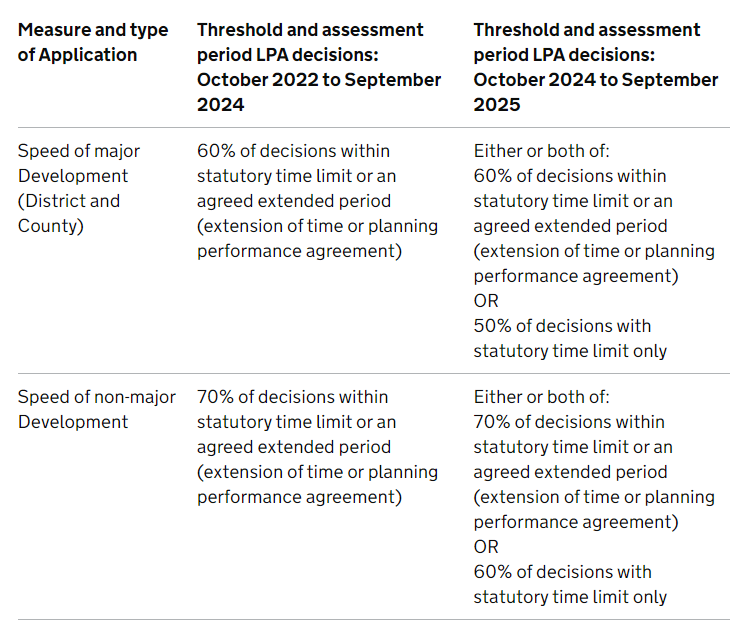Whether tis nobler in the mind to suffer the slings and arrows of outrageous fortune. Or to take arms against a sea of troubles by amending your permission to reflect current market or occupier requirements? Because, of course, in the equally timeless words of Gary Barlow, everything changes.
The main part of this blog post is a detailed examination by my Town Legal colleague Susie Herbert of the potential opportunities arising from use of section 73B of the 1990 Act, introduced by way of the Levelling-up and Regeneration Act 2023, and its potential limitations and ambiguities versus section 73. It’s an important part of DLUHC’s current consultation as to an accelerated planning system which I said I would come back to in my 9 March 2024 post that covered the rest of the proposals.
But first, an interesting appeal decision letter from last week. You may remember that for a temporary period (2013 to 2016) there was a specific statutory procedure, section 106BA, which allowed developers to apply to modify or discharge planning obligations in a section 106 agreement on the basis that they made the development unviable.
Since the repeal of section 106BA the question often arises as to how we might still achieve the same ends. After all, an application under section 106A to amend a section 106 agreement can only be made if the agreement is at least five years’ old. Otherwise, in proposing a deed of variation to the existing agreement, you are in the local planning authority’s hands with no right of appeal.
The alternative options would be to make an entirely fresh application for planning permission (an onerous process) or, conceivably, to make an application under section 73 for removal or variation of a condition attached to the previous planning permission and to use the application as a vehicle for proposing an amended form of planning obligation. The section 73 route was accepted by an inspector in a decision letter dated 25 March 2024 in relation to a proposed development in Thornton Heath, Croydon. There is an existing planning permission for 57 new dwellings , with a section 106 agreement requiring 35% of the homes to be delivered as affordable housing. A Section 73 application was made to amend condition 2 attached to the permission which set out a list of the approved drawings, proposing amended drawings increasing the proportion of three bedroom homes and external alterations to fenestration and elevations. A section 106 unilateral undertaking was put forward proposing no affordable housing, on the basis of a viability appraisal, which had been reviewed and accepted by the local planning authority. The application was not determined within the statutory period and the developer appealed. The authority resisted the appeal on the basis that a section 73 application was not the appropriate means to reduce the level of affordable housing previously secured.
Having reviewed the relevant case law in relation to section 73, the inspector allowed the appeal:
“In this instance, a change in policy has not made it appropriate or essential to amend the obligation. However, there has been a significant change in circumstances relating to the viability of the scheme. It seems to me that it is a matter of planning judgment whether the change in circumstances makes it appropriate, essential or desirable to enter into a planning obligation in different terms to the original. Given the case law outlined above, the terms of a new obligation may be connected to or intertwined with the amendments sought to the drawings, but there is nothing of substance to suggest they must. Consequently, it would be going too far to suggest an amended obligation must be a consequence of, or directly related to, changes flowing from the proposed alterations detailed on the new drawings.
There is no dispute between the Council and appellant that since the original permission was approved, and the evidence underpinning it prepared, construction costs have rapidly risen whilst house prices have remained static. This has had a significant impact on the viability of the scheme. As mentioned above, the situation is so altered that the Council and appellant agree the scheme can no longer provide affordable housing and remain viable. Moreover, there is also common ground that the provision of affordable housing is not a benefit, alone or taken with other factors, which is required to outweigh any harmful impacts emulating from the scheme. Indeed, the Council has only identified limited harm in respect of the housing mix, which is outweighed by other considerations in any event. In these circumstances, altering the level of affordable housing would not be a fundamental change to the proposal.
Therefore, the current circumstances are such that there is a need for a planning obligation in different terms to the original to facilitate delivery. The altered terms of the planning obligation would be consistent with the development plan taken as a whole. The consequence being that the change would not have a bearing on whether the scheme would be acceptable. Thus, the amended planning obligation is necessary, reasonable, supported by development plan policy and proportionate in the context of the prevailing circumstances. Therefore, it is desirable, essential and appropriate to consider a planning obligation in different terms to the original, namely the provision of 0% affordable housing with a review mechanism as required by the LP. In conclusion, the s73 application is an appropriate means in this instance to reduce the level of affordable housing relative to that previously secured.”
The case is another example of the potential flexibility of the existing section 73 procedure, notwithstanding the constraints imposed by the courts – particularly by way of Finney (the inability to use section 73 where the desired changes would be inconsistent with the description of development on the face of the existing permission (leading to a workaround in practice, with a willing authority, by way of use of section 96A in conjunction with section 73 – see my previous blog post here for more information).
Section 73B
So will the new section 73B procedure be the solution. Over to my colleague Susie Herbert for the detail…
On Budget Day, 6 March 2024, DLUHC launched a consultation on accelerating the planning system which closes on 1 May 2024. As well as proposals relating to the application process, this includes a consultation on the implementation of section 73B to vary planning permissions and on the treatment of overlapping permissions. This post concentrates on the proposals concerning variations to planning permissions via the new section 73B and the proposals for overlapping permissions.
Section 73B was introduced by the Levelling-up and Regeneration Act 2023 (“LURA”). The provision is headed “Applications for permission not substantially different from existing permission”. It is not yet in force and secondary legislation is required to specify the application procedure including consultation arrangements, information requirements and the application fee as well as amendments to the CIL regulations. The government proposes to implement section 73B following the consultation “as soon as parliamentary time allows”.
The consultation asks questions on:
- The scope of the proposed Planning Practice Guidance relating to section 73B;
- Procedural arrangements for a section 73B application;
- Application fees for section 73B applications;
- CIL and section 73B applications.
As background, the introduction to this section of the consultation notes “The ability to vary planning permissions in a proportionate, transparent and timely manner is an important feature of the development management system. It is common for developments, particularly if they are large, to require variations to the planning permission in response to further detailed design work, new regulatory requirements, and changing market circumstances. Without this flexibility, development risks being delayed or abandoned as the only option would be the submission of a brand new application for the development which would create uncertainty, delay and further costs.”
The consultation notes that the current legislative routes to varying planning permissions are section 73 and section 96A. In 2009, guidance was introduced on “Greater Flexibility for Planning Permission”. It was at this point that section 96A was introduced into the legislation to allow for “non-material” amendments to existing planning permissions. The guidance envisaged that section 73 could be used for “minor-material” amendments by varying a condition that listed the approved plans by substituting new plans that showed the varied scheme.
However, in 2020, the Courts confirmed that section 73 cannot be used to amend the description of development (Finney). Therefore, the scope to use section 73 to make “minor material amendments” by varying a condition which lists the approved plans is limited.
Although not expressly explained in the consultation document, the reason that the inability to use section 73 to amend the description of development causes such difficulties in practice is because the case law has established that a permission granted under section 73 cannot introduce a condition which creates a conflict or is inconsistent with the description of development. It has therefore become standard practice to minimise the level of detail provided in the description of development and thereby reduce the potential for future scheme amendments to conflict with the description. In some cases an original description of development can be amended via s96A to remove detail from the description of development into a condition and thereafter amend this condition via section 73.
Section 73B is intended to deal with this issue by allowing both the description of development and the conditions to be varied in a single process. The restriction on the use of section 73B is that the amended development cannot be “substantially different” from the existing development.
“Subtantially different”
A key point in the consultation is that the Government does not propose to provide prescriptive guidance on is what is meant by “substantially different”. The consultation notes that section 73B does not provide a definition of the test and that it will depend on the scale of the changes required in the context of the existing permission. Factors that could be relevant are location and the scope of the existing permissions and the proposed changes.
It is not clear where “substantially different” will sit on the scale of potential changes. We note that this term was used in the 2009 guidance on flexible planning permissions in respect of what was meant by a “minor material amendment” which stated:
“We agree with the definition proposed by WYG: “A minor material amendment is one whose scale and nature results in a development which is not substantially different from the one which has been approved.” This is not a statutory definition.”
This suggests that the intention may have been that section 73B was intended to align with the minor material amendments that the guidance envisaged to be made under section 73 with the additional ability to amend the description of development (to make “non-substantial” changes).
However, since this drafting was introduced into the Levelling Up and Regeneration Bill, the Armstrong and Fiske cases have confirmed that section 73 is not restricted to minor material amendments. It is helpful that at footnote 4, the document expressly states that “the department acknowledges that section 73 is not limited in scope to minor material amendments” following the recent cases of Armstrong and Fiske. The judge in Fiske held that there is a restriction on the scope of section 73 which is whether the alteration is fundamental (while in Armstrong the judge had considered that even this restriction did not apply and the only restriction is consistency with the description of development).
Therefore, if the scope of changes allowed by section 73B is intended to be similar to “minor material amendments”, there is the possibility that section 73 would actually allow more flexibility as it extends to “not fundamental” amendments (provided always that it is possible to remain within the description of development).
While it is understandable that the Government does not propose to provide prescriptive guidance on the meaning of “substantially different” because it will be a matter of judgement dependent on the context (as for section 96A), it is clear that the application and interpretation of this provision by each LPA is going to be a key to how useful this provision is in practice.
The consultation states that the government’s proposed objective is for the section 73B route to replace the use of section 73 to deal with proposals for general material variations while the use section 73 would return to focus on the variation of specific conditions and that it proposes to introduce guidance to this effect.
It would therefore be helpful if the scope of changes allowed under section 73B was not less that the scope of changes that could be made via a section 73/ section 96A approach: otherwise the end result of the changes would be more complexity but less flexibility. It does not seem that it would be overly prescriptive for the Government to provide guidance to this effect. It would also be consistent with the general proposed approach of treating a section 73B application in a similar way to a section 73 application in terms of procedure (as detailed below).
Features of section 73B
The consultation summarises the key legal features of section 73B as follows:
- a section 73B application must identify the existing permission (which cannot be a section 73, section 73A or other section 73B permission, or permission granted by development order), and can propose conditions for the new permission;
- as an application for planning permission to a local planning authority, the determination of a section 73B application is subject to section 70 and other decision making duties. But the local planning authority cannot grant permission for a section 73B application if the effect of the section 73B permission would be substantially different from the existing permission, and when determining the application, they must limit their consideration to the variation between the application and the existing permission; and
- like a section 73 permission, a section 73B permission is a separate permission to the existing permission (and any other section 73 or 73B permissions related to the existing permission) so the granting of a section 73B permission does not affect the validity of the existing permission (or other section 73 or 73B permissions).
The provision also applies to applications for permission in principle.
Proposed general approach
As noted above, the Government’s proposed objective is for the section 73B route to replace the use of section 73 to deal with proposals for general material variations while the use section 73 would return to focus on the variation of specific conditions. The consultation notes that because section 73 cannot be used to amend the description of development, it has become common practice to submit generic descriptions of development which do not specify key feature such as the number of dwellings with those details set out in conditions to allow them to be varied via section 73. The consultation identifies that a benefit of using section 73B would be to allow a return to clear and more specific descriptions which would help improve the transparency of development proposals for local communities.
The Government therefore proposes to use Planning Practice Guidance to encourage the use of clearer, more transparent descriptors of development and the use of section 73B to deal with general material changes to development granted planning permission. The consultation asks “do you agree that guidance should encourage clearer descriptors of development for planning permissions and section 73B to become the route to make general variations to planning permissions (rather than section 73)? (Question 26)” and “also for any further comments on the scope of the guidance (Question 27)”. This includes the question of whether the guidance should discourage the use of the, now standard, condition which lists approved plans which was introduced to facilitate minor-material amendments via section 73. The consultation states that they are not minded to discourage the use of this condition and that it is beneficial to help support effective planning enforcement, particularly in relation to design.
Procedural arrangements
The aim is for the procedural requirements set out in regulations for a section 73B application to be “proportionate reflecting the position that the development proposed in the application is a material variation to an existing permission while still ensuring there is transparency about the proposed variation” and that “Local communities should be aware of proposed variations so they can make representations: the section 73B route is not a mechanism to undermine scrutiny.”
The proposal is:
- information requirements will be generally the same as other applications for planning permission but certain requirements (such as a design and access statement) will not be required.
- publicity requirements will be the same as other applications for the type of development (i.e. if it is a variation to major development, the major development publicity requirements would apply).
- Consultation with statutory consultees would follow the approach of section 73 applications where there is a duty on the local planning authority to consult a statutory consultee if they consider appropriate (reflecting the position that a proposed variation may only engage specific issues which of an interest to only some statutory consultees and so it would be disproportionate to require those statutory consultees without an interest to respond) although the footnote states that applications would automatically be in scope of the consultation duty between counties and district LPAs, the consultation arrangements for parishes and neighbourhood forums and the arrangements for applications of potential strategic importance under section 2A TCPA 1990 for the Mayor of London and those combined authorities which have section 2A powers.
EIA and HRA requirements would apply as for section 73 permissions and a similar approach would be taken to Biodiversity Net Gain.
The consultation asks whether consultees agree with this proposed approach to procedural requirements.
Fees
The proposal is to align the fee for a section 73B application with the fee for a section 73 application. The alternative approach of setting a higher fee for a section 73B application was considered on the basis that the section 73B route could be the default route for general material variations while section 73 focuses on the variation of a specific condition. However, the higher fee could encourage applicants to continue to use section 73, undermining the purpose of the reform.
However, it is proposed to change the current flat fee approach for a section 73 application (£293) so that there would be three separate fee bands for householder, non-major development and major development.
The householder fee would be reduced to £86 (double the fee for discharge of condition and removing the anomaly that an original householder application fee is lower than the section 73 fee). The non-major development fee would remain at £293.
For major development, there would be a higher fee which would be less than the fee for the original application and proportionate to the work necessary to consider the proposed variation (without exceeding full cost recovery). The consultation asks for views about where this fee should be set, including evidence from local planning authorities for the typical work which is involved dealing with an average section 73 application for a major development.
CIL
It is proposed that CIL would apply to section 73B in the same way that it applies to section 73 permissions. This would mean that “if the section 73B permission does not change the CIL liability, the chargeable amount is that shown in the most recent liability notice issued in relation to the previous permission. But if the section 73B permission does change the CIL liability, the most recently commenced or re-commenced scheme is liable for the levy.”
Overlapping permissions and section 73B
The consultation refers to the recent Hillside and Dennis cases on overlapping permissions [see previous simonicity blog posts respectively here and here] and how these judgments have questioned the ability to use ‘drop in’ permissions where a subsequent permission is granted for an alternative development on a section of a larger development previously granted permission and still being implemented.
It summarises Hillside as confirming existing caselaw that “full planning permissions are not usually severable. That is to say, parts of the permission cannot be selectively implemented and that, if a new permission which overlaps with an existing permission in a material way commences, should the carrying out of the new permission make it physically impossible to carry out the rest of the existing permission, it would be unlawful to continue further development under the existing permission. The Court then went on to say, if someone wanted to change part of the development, they should seek to amend the entire existing permission.” And notes that Dennis considered the implications for outline planning permissions and the question of severability further.
It notes that “drop in permissions have often been used during the implementation of outline planning permissions for large scale phased residential and commercial developments where a new development is proposed through a separate application for a phase outside the scope of the outline planning permission while the rest of the phases continue to be implemented under the outline permission. This approach has provided a flexible way of enabling changes to a specific phase to be managed through planning without having to seek a new planning permission for the entire development, particularly when the scale of change is outside the scope of a section 73 application.”
In terms of section 73B, “The government believes that the new section 73B route provides a new way of dealing with such changes to a specific phase of a large scale development granted through outline planning permission in many cases. While the use of section 73B is constrained by the substantively different test, these changes often continue to fit within the existing masterplan which underpins the outline permission and do not necessarily fundamentally change this permission – for instance, changing a phase of commercial development (use class E) to a cinema (use class – sui genesis) where the outline permission only allows class E uses. In this case, the section 73B application would provide details of the proposed variation to the outline planning permission and the consideration by the local planning authority would focus on the merits of this variation.”
However it is recognised that “there could be circumstances where the section 73B route may not be appropriate – for instance, if the change could be considered to be substantially different or there are wider financial and legal relationships between the master developer, land owners and investors which makes the preparation of a section 73B application difficult.”
The consultation asks for views about the extent to which the section 73B route could be used to grant permission for changes for outline planning permission in practice and what the constraints are.
It is clearly helpful that the consultation acknowledges that a new use could be introduced via section 73B which gives more potential flexibility and simplicity than a section 73 approach. However, as noted, changes may well be considered “substantially different” even if they allow the remainder of a masterplan to be developed without amendment. There are also undoubtably complications in obtaining a new planning permission (even a section 73B) for an entire site where development has started and different plots are being developed by different developers, particularly if a section 106 agreement is required to be varied.
The final section of the consultation is a proposal to create a framework through a new general development order to deal with circumstances that cannot be addressed via section 73B. This general development order would deal with overlapping permissions in certain prescribed circumstances. It notes that the Secretary of State has broad powers under section 59 of the Town and Country Planning Act to provide for the granting of planning permission through an order, including classes of development. This may be for a specific development or for a class of development.
The consultation asks for views on whether the focus of such an approach should be on outline permissions for largescale phased development or whether there are any other categories of development which could benefit from an alternative approach.
The consultation questions are:
Question 33. Can you provide evidence about the use of the ‘drop in’ permissions and the extent the Hillside judgment has affected development?
Question 34. To what extent could the use of section 73B provide an alternative to the use of drop in permissions?
Question 35. If section 73B cannot address all circumstances, do you have views about the use of a general development order to deal with overlapping permissions related to large scale development granted through outline planning permission?
It is not clear what the general development order proposal would entail but it is clear that an alternative approach for circumstances where section 73B cannot be used would be valuable and it is encouraging that the government is exploring further options to address the Hillside issue.
Thanks Susie for the above. Given ongoing concerns that I suspect many of us have both as to the need for a proportionate procedure for amending permissions but also more specifically to find a solution to the unnecessary complexities we all face by way of Hillside and Dennis, this is going to be an important consultation process.
The uncertainties as to whether “minor material” “substantially different” and “fundamental alteration” also bring to mind the consideration given recently by the Planning Court to whether, in the NPPF, “substantial” has a different meaning to “significant“, in Ward v Secretary of State (Lang J, 25 March 2024) (answer, after lengthy and unnecessary confusion which could have been prevented by accurate language used at the outset: nope).
Simon Ricketts, 1 April 2024
Personal views, et cetera

Edwin Booth as William Shakespeare’s Hamlet, circa 1870, courtesy Wikipedia













